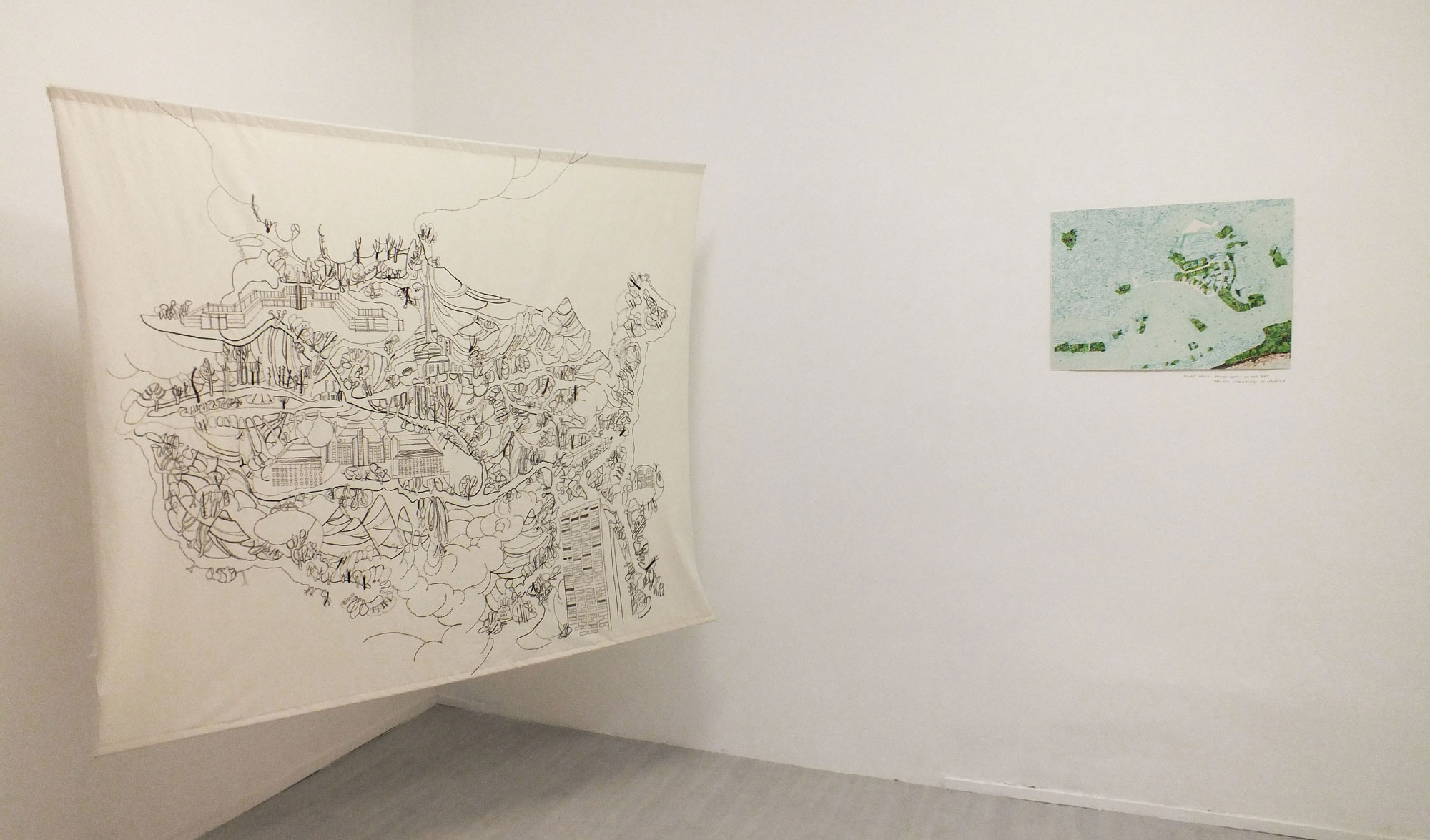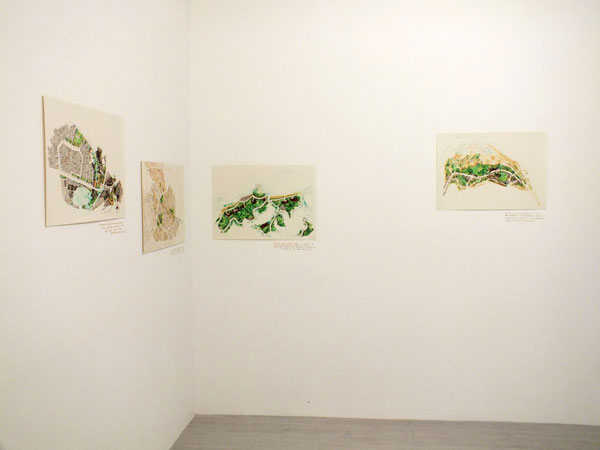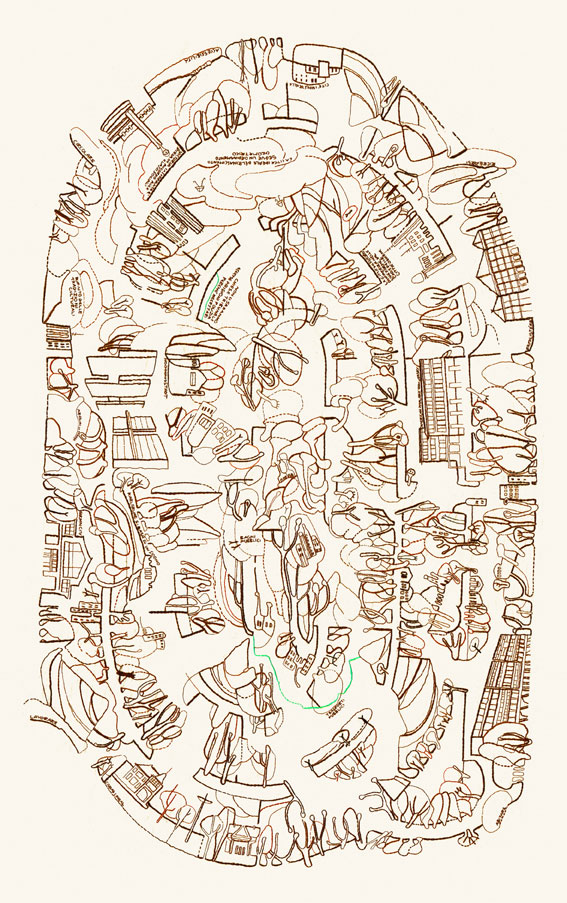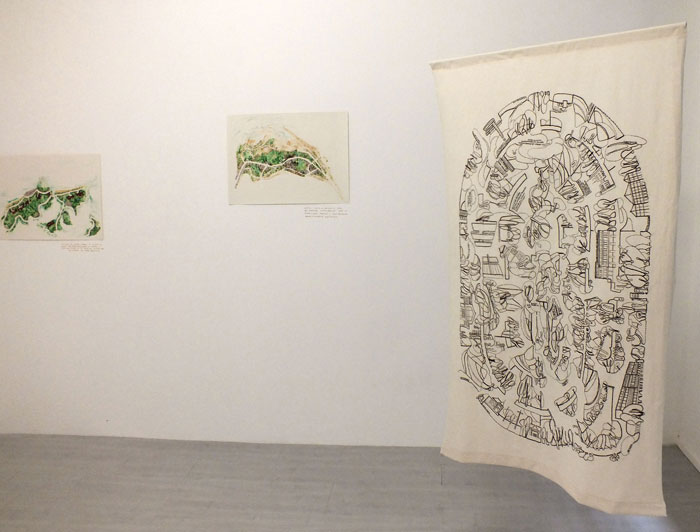
| home rebecca agnes | books | texts | links | bio | cv |
 |
VEDUTA INSTALLAZIONE DELLA MOSTRA DYS-FUNCTIONAL CITIES GALLERIA DAVIDE GALLO, MILANO. A sinistra "Phalanstère, Familistère, unité d'habitation" ricamo a mano (a punto erba) su cotone 200 x 165 cm circa, fili colorati in varie gradazioni di marrone. A destra "Do not eat or seat, remain standing/ Venezia", disegno su carta, matita e pennarello, 50x70, 2014.
Nei disegni l’artista parte da un dato personale, questi infatti si riferiscono a città e luoghi reali. I disegni denunciano l’inganno della bellezza metropolitana, che di fatto cela restrizioni, e chiusure. Ci sono limiti che possono rimanere nascosti per chi non ne ha esperienza diretta, la loro ovvietà può sfuggire alla consuetudine o nascondersi dietro la bellezza. I processi in atto nelle città sono espressione del modo in cui la nostra società è strutturata. I disegni sono una critica all'ordinamento dello spazio cittadino, che spesso non prende in considerazione le reali esigenze degli abitanti, ma cerca di omologare gli individui allo standard di un individuo-tipo, escludendo ciò che è difforme o alternativo ad un ordinamento sociale tradizionale. I ricami, che fanno da contrappunto ai disegni, sono riflessioni su approcci alternativi all'abitabilità. Il primo ricamo, dal titolo Phalanstère, Familistère, unité d'habitation, è un breve escursus storico, che parte dalle prime proposte dell'urbanismo utopico per arrivare al modernismo e a complessi urbani realizzati in anni recenti. Il ricamo rappresenta un "paesaggio ricamato" da cui emergono 3 architetture collegate tra loro da una strada-sentiero. Il primo è il “Falansterio” di Charles Fourier (1822), struttura abitativa in cui si svolge la vita dei membri dell'unità sociale di base chiamata "Falange". Il Falansterio è di fatto il progetto di una vera e propria città, un complesso pensato per 1620 abitanti, che si sviluppa in una serie di edifici collegati fra loro, fino a creare un unico edificio regolare. E' una città autosufficiente che produce e opera collettivamente. Proseguendo il percorso abbiamo un progetto realizzato fra il 1856 e il 1859 da Jean-Baptiste André Godin: Familistère. Godin parte dalle teorie di Fourier. La sua intenzione era quella di migliorare le condizioni abitative dei lavoratori, ma anche "di produzione, scambio, fornitura, istruzione, e ricreazione", tutte le sfaccettature della vita di un lavoratore moderno. In Godin è la relazione uomo-produzione ad essere al centro della sua utopia urbanistica. Alla fine del sentiero abbiamo la facciata di una delle Unité d'Habitation di Le Coubousier (1947). Una sorta di città nella città. Concepita come una vera e propria "città verticale" caratterizzata da spazi individuali inseriti in un ampio contesto di aree comuni. Queste architetture, se nascondono un aspetto fallace, nell’ impossibilità a creare il luogo "perfetto", svelano comunque il tentativo di fare dello spazio un problema sociale, sicché tali utopie rimangono esperienze fondamentali da cui partire per poter elaborare nuove strategie Il secondo ricamo, dal titolo La ricerca della città perfetta e le 4 funzioni umane, si ispira alla Carta di Atene del 1938. Nella Carta di Atene si specificano i principi fondamentali della città contemporanea ed è un documento fondamentale del Movimento Moderno e della sua visione dell'Urbanistica. Fra i vari punti vengono a delinearsi 4 funzioni umane: abitare, lavorare, divertirsi e circolare. Queste 4 funzioni base sono riportate ai 4 angoli dell’arazzo: caselle di partenza per iniziare il gioco dell’oca che il ricamo riproduce. Un gioco in cui non esiste vincitore o fine, perché le caselle sono collegate fra loro senza soluzione di continuità. Sulle caselle stesse si trovano qua e là dettagli di edifici e note. Ovviamente rimangono aperte le seguenti questioni: Ma a quale cittadino/a sono rivolti tali progetti? Quale può essere il minimo comun denominatore fra gli individui e le loro necessità? In che modo l'abitare può rimanere un processo aperto (fluido) anziché restrizione e ordinamento imposto dall'alto? Sia i disegni che gli arazzi svelano delle norme. Da un lato la bellezza dei disegni nasconde le restrizioni che incontriamo quotidianamente, dall'altro le "buone" intenzioni dell'urbanistica "sociale" che si esemplificano nelle architetture modulari presenti sul primo ricamo e nella “Carta di Atene” del secondo. |
INSTALLATION VIEW SOLO SHOW DYS-FUNCTIONAL CITIES DAVIDE GALLO GALLERY, MILAN. On the left "Phalanstère, Familistère, unité d'habitation" hand made embroidery on cotton 200 x 165 cm ca. colored threads in various shades of brown. On the right "Do not eat or seat, remain standing/ Venice", drawing on paper, pencil and pen, 50x70, 2014.
The drawings in which the artist uses a personal data, refer to cities and real places. The drawings report the deceit of metropolitan beauty that actually hides restrictions and closures. There are limits that can remain hidden to those who do not have a direct experience of them, their obviousness can elude custom or hide behind beauty. The processes taking place in the cities are an expression of how our society is structured. The drawings are a criticism to the organization of the city space that often does not take into consideration the real needs of the citizens, but tries to homologate individuals to a standard, excluding those that are dissimilar or alternative to a traditional social order. The embroideries, which act as counterpoint to the drawings, are thoughts about alternative approaches to habitability. The first embroidery is entitled Phalanstère, Familistère, unité d'habitation. This work is a brief historical excursus, which starts from the first proposals for utopic urbanism to get to modernism, and to urban complexes made in recent years. The embroidery represents a landscape from which emerge three architectures connected by a road-trail. The first is the “Phalanstery” of Charles Fourier (1822), residential facility in which the life of members of the base social unit named "Phalanx" takes place. The Phalanstery is actually the project of a real city, a unit thought for 1620 inhabitants that develops in a series of buildings connected with each other to create one regular building. It is a self-sufficient city that produces and works collectively. Pursuing this path we have a project carried out between 1856 and 1859 by Jean-Baptiste André Godin: Familistère. Godin starts from Fourier theories. His intention was to improve the living conditions of workers, but also "of production, trade, supply, education and recreation", all facets of the life of a modern worker. In Godin the relationship man-production is the center of his urbanistic utopia. At the end of the path we have the façade of one of the Unité d'Habitation of Le Coubousier (1947). A sort of city within a city. Designed as a true "vertical city" characterized by individual spaces included in a broader context of common areas. These architectures, hide a fallacious aspect, in the impossibility to create the "perfect" place, but reveal however, the attempt to make the space a social problem, so that these utopias remain fundamental experiences from which to develop new strategies The second embroidery is entitled La ricerca della città perfetta e le 4 funzioni umane. In the Athens Charter of 1938 the basic principles of the contemporary city are specified; it is a fundamental document of the Modern Movement and of its vision of town planning. Among the various points emerge 4 human functions: to live, work, play and move. These four basic functions are shown at the 4 corners of the tapestry: start boxes to begin the game of the goose that the embroidery reproduces. A game in which there is no winner or end, because the boxes are connected to each other seamlessly. On the boxes there are here and there, details of buildings and notes. Of course, the following questions remain open: which citizens these projects are aimed to? What can be the lowest common denominator between individuals and their needs? In what way the dwell can remain an open (fluid) process rather than restriction and order imposed from above? Both the drawings and the tapestries reveal some rules. On the one hand the beauty of the drawings hide the restrictions that we encounter on a daily basis, on the other hand, the "good" intentions of "social" urbanity that exemplify in the modular architectures on the first embroidery and in the "Athens Charter" of the second. |
 |
|
| VEDUTA INSTALLAZIONE DELLA MOSTRA DYS-FUNCTIONAL CITIES GALLERIA DAVIDE GALLO, MILANO. Sotto "La ricerca della città perfetta e le 4 funzioni umane" ricamo a mano (a punto erba) su cotone 100 x 165 cm circa, fili colorati in varie gradazioni di marrone e un filo turchese, 2014. | INSTALLATION VIEW SOLO SHOW DYS-FUNCTIONAL CITIES DAVIDE GALLO GALLERY, MILAN. Down "La ricerca della città perfetta e le 4 funzioni umane" hand embroidery on cotton 100 x 165 cm, colored threads in various shades of brown and a turquoise thread, 201 |
 |
|
 |
| NEXT |
| home rebecca agnes | books | texts | links | bio | cv |